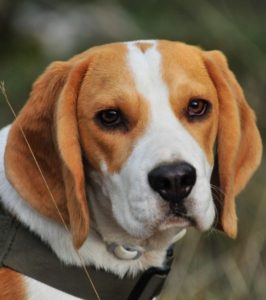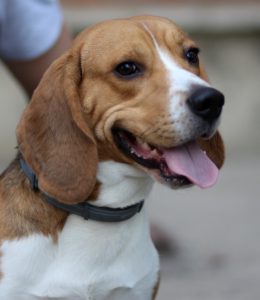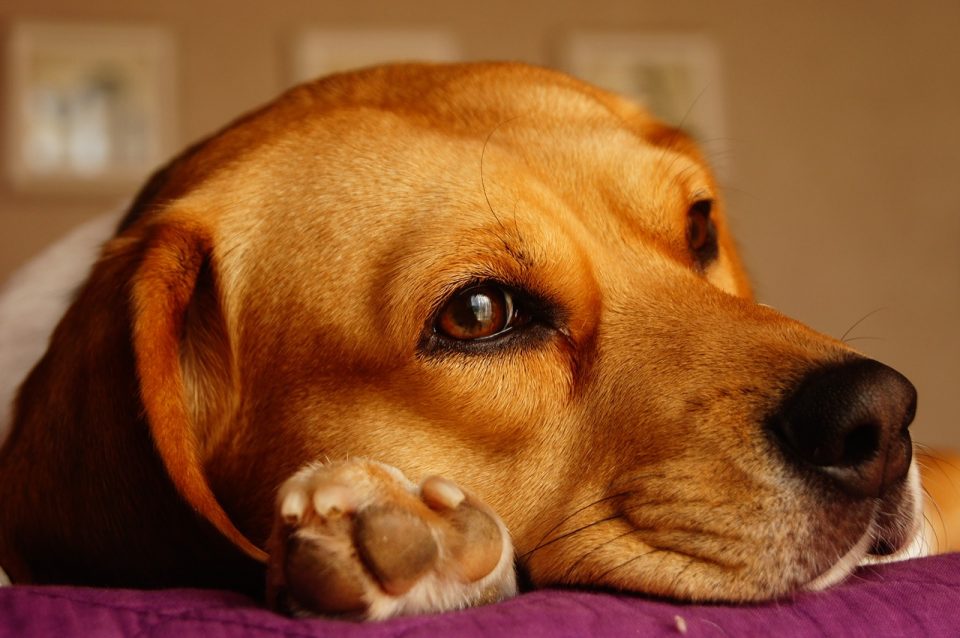One of the most common questions asked when looking into a new breed is “do they shed?”.
It’s a super important question, too. Shedding can play a big part in your final decision when finding your perfect dog.
One extremely popular breed? The beagle. It’s loved by so many people, they’re the perfect medium of just about everything.
However, just because they’re not too big or small, doesn’t mean that you should ignore their shedding habits.
This can be a big concern for those that have allergies, or simply don’t have the means to deal with shedding.
To answer your question quickly; yes beagles do shed. However, because they’re (relatively) small, it is not overly noticeable.
When the warmer months come around, they begin to grow out of their winter coat – and the shedding can be hard to deal with. Once you know how to deal with it, it does become manageable.
Luckily, they don’t shed as heavy as other breeds – but they do require a certain degree of grooming and cleaning. So, let’s explore everything about Beagles and their adorable coat.
In this guide, we look at why beagles shed, how to keep it to a minimum, and the best equipment to use.
A Short History of the Beagle
The Beagle is one of the most popular breeds – I won’t even need to explain what they look like. However, to really understand their shedding habits, it’s important to look into their history.
The beagle dates right back to the 5th century – originating in Ancient Greece. Dogs of a similar size and purpose (which is hunting) can also be traced back to this date.
In the 8th century, there was a breed known as the St.Hubert Hound. This dog’s primary purpose was hunting and looked similar to the Beagle.
However, it ran too slow – which didn’t serve it well for its job. In the 11th century, William the Conqueror brought the Talbot Hound to England.
It’s thought that it was then bred with the Greyhound – this was an effort to make the hunting dog a little bit faster.
This new breed was called the Southern Hound – this is thought to be an ancestor of the Beagle.
In fact, in medieval times, “beagle” referred to any dog that was a hound dog.
There was even “Pocket Beagles”, which were tiny (around 8 to 9 inches from the ground to shoulder). These became extinct by the 1900s.
The Modern Beagle
 In 1830, Reverend Philip Honeywood established a breeding programme. This is believed to be the basis of the modern Beagle that we know and love today.
In 1830, Reverend Philip Honeywood established a breeding programme. This is believed to be the basis of the modern Beagle that we know and love today.
By the 1840s, the standard Beagle was starting to develop. At this time, there was around 4 different types – the medium Beagle, the dwarf Beagle, the Fox Beagle, and the Terrier Beagle.
In 1890, the Beagle Club was formed. A mission was formed – to produce one standard type of Beagle.
Today, the Beagle is used for way more than hunting. It’s commonly just a loved family pet.
The Beagle’s considered to be one of the world’s most popular breeds. It’s a loving, loyal and friendly dog – perfect for work, young families, and the elderly alike.
What is a Beagle’s Coat Like?
Apart from being super cute, what actually is a Beagle’s coat like?
They basically have a super smooth, dense double coat. It’s resistant to rain – making them perfect for outside life and swimming.
Their coat gets heavier in the winter months, making spring the shedding season.
They do, however, shed a moderate amount all year round. This means that grooming and cleaning should be a regular occurrence.
The Beagle has a dense coat, which is perfect for hunting. Beagles were bred to hunt – they have an incredible nose with 220 million scent receptors.
They would track down the game for humans, with their incredible noses.
As they were hunting companions, they needed to be out where the bushes, twigs, shrubs, and other rough terrain was.
A dense coat acts as a protective shield for the Beagle. In fact, all hunting hounds need a dense coat.
Their coat is also made for the cold climate. Of course, if you’re from England, you need a warm coat!
Great Britain is far from your tropical weather – it’s constantly cold and rains a lot. Temperatures can reach below 0 degrees Celsius.
As a hunting dog, the Beagle would have to spend a long time outside. Thus, it needs a coat that keeps it super warm.
So, although the Beagle’s hair is short and dense, it actually does a really amazing job at insulating its body. It keeps the body heat trapped.
Obviously, with a thick dense coat, this basically means that there’s more hair on the dog. This makes for more potential for shedding.
The Double Coat
The Beagle also has a double coat. Most breeds only have a single coat. This is exactly what it sounds like.
Basically, a Beagle has two layers of fur. Again, this is to protect it from the environment.
The undercoat is the bottom layer – this feels a little bit like wool and helps to insulate. The second layer is the top coat.
This acts as an external layer of protection – mainly to help protect against all those twigs, debris and dirt. It’s this coat that makes the Beagle waterproof, too. How amazing.
Of course, with two layers of fur, there’s more opportunity for the Beagle to shed.
It has to be noted, double-coated dogs are notorious for being extreme shedders, especially when the warmer seasons come around.
Their coats are constantly adjusting to the season. So, there will be more shedding. This is something that you need to accept, consider, and deal with. For this reason, it’s important to know.
Do Beagles Shed?
 As stated above, yes Beagles do shed. They shed more than other breeds – which is certainly something you need to consider.
As stated above, yes Beagles do shed. They shed more than other breeds – which is certainly something you need to consider.
Nearly all dogs will shed to some extent. There’s really nothing you can do about it – if you’re planning on adopting a fur baby, you have to expect the fur flying around.
You can, of course, go with a hairless dog breed. This is definitely an option for those with allergies or adversity to excessive fur in their house or apartment.
Beagles are considered a moderate to heavy shedding breed. This is due to their dense double-coat.
The good news? This means that they’re the perfect hunting or farming dog. Their coat has basically been designed for outside life.
However, be aware that their coat isn’t made to protect them from overtly harsh weather conditions.
They will suffer from frostbite, hypothermia, and other fatal conditions if they are subject to extreme cold climates.
When do Beagles Shed the Most?
Apart from hairless breeds, every dog will experience seasonal shedding, to some degree. Obviously some experience it a little bit more than others.
Beagles, unfortunately for some, do fall into the more extreme category. I know this might be a bit of a deal-breaker for some, but it’s important to know.
Seasonal shedding is very common, but for those with double coats, it’s much more noticeable.
This means you’ll experience a lot of brushing up and vacuuming, as well as a lot of loose fur getting stuck to clothes and furniture.
So, why do Beagles shed more in spring and summer?
When it’s time for the spring season, a Beagle will begin to shed it’s heavy, dense winter coat. It’s just preparing for summer.
You wouldn’t wear your winter clothes in warm weather, would you?
During the warmer months, a Beagle will grow out their lighter coats. This enables them to stay cooler during the spring and summer – again making them more adaptable to outside living.
Similarly, when it’s time for autumn and winter the Beagle will need to shed its summer coat.
This way, it can make way for its winter coat – regrowing a thicker body of fur. That’s essentially the shedding cycle of a Beagle in a nutshell.
Professionally, this is called the “coat blow”. During the blowing of a coat, it’s totally normal for your Beagle to experience excessive shedding.
For new or unprepared owners, this can be really worrying or startling. Firstly, you need to understand that it’s normal – sometimes big clumps might fall off at a time.
Although it may be slightly annoying, it is really nothing to be alarmed about.
How to Combat Beagle Shedding?
Sure, your Beagle might shed a lot – and this might be a nightmare. You can reduce the amount they shed.
Please be aware that these methods involve grooming. If you’re not prepared to spend the time or money on grooming your dog, a Beagle may not be the best option for you.
Brushing
This is one of the easiest ways to keep their shedding manageable.
It doesn’t take a great deal of time, but it does minimize how much fur ends up around the house.
Bathing
You need to give your Beagle frequent baths. However, don’t bathe them too often. It’s important to find a good medium ground.
Too many and your Beagle’s fur will be stripped of all the good natural oils. Aim for every two to six months.
Avoid shaving
Many owners resort to shaving their Beagle. This isn’t something I recommend and can harm your Beagle’s coat.
It’s only a temporary solution and can make your dog’s fur almost like velcro.
Equipment Help to Combat Beagle Shedding
 There’s really only one piece of equipment you need – a good brush. There’s plenty of options out there. Make sure you’re finding a brush that’s designed specifically for short-haired, dense, double coats.
There’s really only one piece of equipment you need – a good brush. There’s plenty of options out there. Make sure you’re finding a brush that’s designed specifically for short-haired, dense, double coats.
Obviously, when bathing your dog – make sure it’s a good quality shampoo. I highly recommend using a natural shampoo, that way you can sure there won’t be any adverse effects.
Remember, Beagles are quite prone to getting smelly. So, if you plan to give them frequent baths, make sure you’re using one that’s gentle on the coat and the skin underneath.
Are Beagles Hypoallergenic?
There’s one thing to understand in regards to this question – no dog is truly hypoallergenic.
Even hairless breeds will produce dander and can aggravate allergies.
Of course, it’s the short-haired dogs like Beagles that can really play havoc with allergies.
It’s true, some dogs are less likely to provoke any allergies, but there is no such thing as a hypoallergenic dog.
Do some Beagles Shed More Than Others?
Yes, they’re all their own individual. Just like humans – some may be more prone to excessive shedding than others.
Sometimes, your Beagle may go through phases on heightened shedding.
However, for the most part, all Beagles shed relatively similar amounts. Unless, of course, there is an underlying reason as to why it’s more than usual.
Health Reasons for Increased Shedding in Beagles
There are certain things that can make a dog shed excessively. If you notice excessive hair loss or bald patches, your Beagle could have one of the following:
Parasites
Fungal or bacterial infections
Kidney, liver, thyroid or adrenal disease
Pregnancy
Inhalant or food-related allergies
It could be a result of medications that they are on, too.
If you’re worried about your Beagle, and the amount of shedding it is experiencing – it could be worth visiting the vets about. It could be nothing, but it could be something. It’s better to be safe than sorry.
Beagle Shedding: Final Thoughts
 So, while they might not have the easiest fur to manage – they’re definitely worth the extra fur hanging around the house.
So, while they might not have the easiest fur to manage – they’re definitely worth the extra fur hanging around the house.
Beagles are loving, loyal creatures. They’re shedding is just a product of their hunting background.
They have been bred to be perfect for outside life. As the owner, it’s just something you have to deal with.
Grooming a beagle isn’t a difficult job. In fact, it can be a really great bonding experience.
With the right tools and products, you can certainly minimize the effects of the shedding – making it much more manageable.
Again, if you are concerned about the amount of shedding your Beagle is experiencing, make sure to check it out with a vet.
